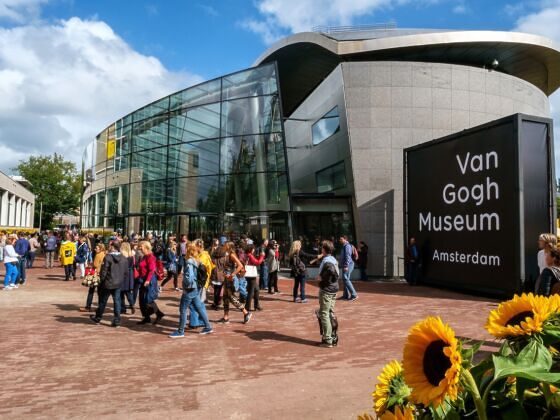VINCENT VAN GOGH never found fame in his lifetime. His short life of painting, debauchery, and good intentions ended in his suicide. Today he’s finally given respect, and his old haunts honour their connections with him.

Amsterdam, Netherlands
Return to Van Gogh’s age of innocence in the city of cannabis and prostitution. Picture a lonely red-headed figure wandering past those canals and charming houses while studying to become a pastor. Lucky for us, Van Gogh failed the theology exam. The results of his lifetime of art hang in the Van Gogh Museum, the largest collection of his works.
After you pay homage to the artist as innocent, consider indulging in the guilty pleasures of Amsterdam. It’s what he would have done, after all.
Nuenen, Netherlands
Van Gogh produced dark portraits of poverty here, including The Potato Eaters. Take the train from Amsterdam for 1.5 hours, stopping in the closest station of Geldrop (5 km/3.1 miles from Nuenen) and head to this Dutch university town.
Though just a preacher’s son, today Van Gogh is the star of the village. Visit his old home, or the street, café, college, and bar named after his works.
Van Gogh Village Nuenen keeps up the Van Gogh Documentation Centre and has produced a walking route through town. His statue in the central park further demonstrates the community’s belated pride.
Paris, France
In Paris, Van Gogh lived the ultimate bohemian lifestyle, joining other artists including Henri de Toulouse-Lautrec and Paul Gauguin. He painted over twenty Self Portraits, his Japanese-inspired pieces, and so many more.
From the Geldrop station, you can make it to Paris in 4-5 hours. When you arrive, stop by a bar that serves absinthe, one of Van Gogh’s favourite vices, and raise a glass of “la fée verte” to him. The Musée d’Orsay is the place to see pieces by Van Gogh, Toulouse-Lautrec, Gauguin, and their contemporaries.
Despite gentrification, their old haunt of Montmartre still has an arty vibe. See it in detail with a guided tour, or choose a more bohemian option — free — on your own. If you want more, pick up the book Van Gogh Walks: Paris, by Priscilla Bain-Smith.
Arles, France
When city life became too much to bear, Van Gogh escaped to Provence. Do the same by taking the TGV from Paris to Avignon or Nimes (both trips 2.5-3 hours). Once in Provence, the best way to see the collection of small towns is by car. Rent one in your destination city, and sightsee before heading to Arles (less than a 45-minute drive).
In contrast to the relaxing countryside, Van Gogh worked at a frantic pace while living here in the Yellow House with Gauguin.
Though no originals remain in Arles, you can see reproductions at the sites they were painted. The tourist board offers a self-guided tour to find them all.
The café of Café Terrace at Night has been painted yellow to match the lamplight in the painting: an obvious attempt to ensnare tourists. Do or do not, but don’t miss the photo op.
Alas, even the Provençal life wasn’t mellow enough for Van Gogh, and it was here he had his great decline and unfortunate ear-cutting incident. Locals even signed a petition for the “fou roux” (mad redhead) to leave town.
Saint-Rémy-de-Provence, France
Van Gogh checked into an asylum at Monastery Saint-Paul-de-Mausol. A half-hour drive from Arles, you can visit today (as a guest, not a patient).
Van Gogh continued to paint during his confinement, so his pictures show the monastery itself and the view from his window, later stretching to the surrounding countryside. Walk the ‘Circuit Van Gogh’ for reproductions of his pieces at the places they depict.
Spend time visiting the historic laneways of Saint Rémy and its lush setting, and stay the night to try to see the sky with an artist’s eyes. This is where Van Gogh painted The Starry Night, after all.
Auvers-sur-Oise, France
Van Gogh moved here and put himself in the care of Dr. Gachet, who became a friend and was also the subject of a famous set of portraits. Head north again to this suburb, a 30-minute drive from Paris.
The Church at Auvers and The Town Hall at Auvers, both from Van Gogh pieces, still stand in this village. A newer arrival is the Musée l’Absinthe, which highlights the café ambiance of La Belle Époque.
Try to find the wheatfield of Wheatfield with Crows, one of Van Gogh’s last and most haunting paintings. Eerily, it may have been the same field where Van Gogh eventually shot himself. He died of his wound two days later in the Auberge Ravoux, the inn where he had been staying.
Today you can visit his room — unchanged since his death — a bookshop focusing on him, and the restaurant — still in business. A final stop pays tribute at the graves of Vincent Van Gogh and his beloved brother Theo, side by side in the Auvers town cemetery.
Community Connection
Yeah, Matador does art too, and it comes in all different colors:
13 of the Coolest Art Installations in the History of Burning Man